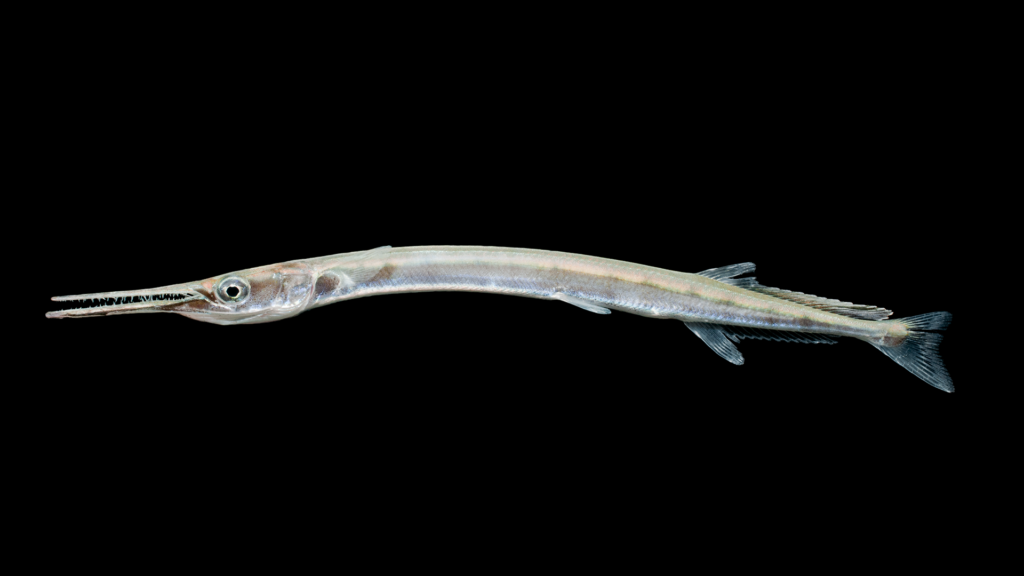By the NCFishes.com Team
The waters along and off the coast are where you will find all five species within the Family Belonidae known from North Carolina (Table 1). One of the five species, Atlantic Needlefish, is also found upstream in the lower Piedmont (more about that later). Because of their superficial resemblance to the freshwater gars (Family Lepisosteidae, https://ncfishes.com/freshwater-fishes-of-north-carolina/lepisosteus-osseus/), one might hear them referred to as gar, Bill-fish, Gar-fish, Green Gar (perhaps because of the green color of the skeleton), or Doctor-fish (perhaps because of their tendency to impale people with their beak when leaping out of the water) (Smith 1907). However, the American Fisheries Society (AFS)-accepted common names provide some logical standardization (Page et al. 2013) and each of their scientific (Latin) name actually means something (please refer to The Meanings of the Scientific Names of Needlefishes, page 8). We are not sure how Tylosurus crocodilus, was tagged with the common name, Houndfish, perhaps because being such an aggressive and voracious predator that they “hound” their prey until capture. But, a more appropriate name could have been Crocodile Needlefish. The AFS-accepted common name of Tylosurus acus is Atlantic Agujón. In Spanish Agujón translates as “needlefish”. So, technically, there are two species with the same common name of Atlantic Needlefish – Strongylura marina and Tylosurus acus.
Table 1. Species of needlefishes found in or along the coast of North Carolina.| Scientific Name/ American Fisheries Society Accepted Common Name | Scientific Name/ American Fisheries Society Accepted Common Name |
|---|---|
| Ablennes hians - Flat Needlefish | Tylosurus acus - Atlantic Agujón |
| Platybelone argalus - Keeltail Needlefish | Tylosurus crocodilus - Houndfish |
| Strongylura marina - Atlantic Needlefish |

One of their vernacular names, Gar-fish, probably originated because of their superficial resemblance to our Longnose Gar, Lepisosteus osseus. However, the two families can easily be told apart. Needlefish has very small cycloid scales, ~ 300 in the lateral line; the dorsal and anal fins are longer than high; the caudal fin is homocercal; and the body is slender. Gar has large ganoid scales, ~ 55 in the lateral line; the dorsal and anal fins are higher than long; the caudal fin is abbreviate heterocercal; and the body is stout (Rohde et al. 2009). Some species of Needlefishes do get as long as gar: Keeltail Needlefish – 380 mm (15 inches), Atlantic Needlefish – 610 mm (2 feet), Atlantic Agujón – 914 mm (3 feet), Flat Needlefish – 1097 mm (3.6 feet), and Houndfish – 1524 mm (5 feet) (Kells and Carpenter 2014; Rohde et al. 2009).

All Needlefishes are schooling species and are to be found inshore and offshore along the coast (Maps 1–5) (NCFishes.com; Tracy et al. 2020) [Please note: Tracy et al. (2020) may be downloaded for free at: https://trace.tennessee.edu/sfcproceedings/vol1/iss60/1.] But unlike the other four species, Atlantic Needlefish migrates readily between fresh and salt water and spawns in fresh water (Rohde et al. 2009). Whether some Atlantic Needlefish spend their entire life in fresh water and/or are permanent residents of far-inland coastal rivers is unknown. Atlantic Needlefish is found seasonally in most Coastal Plain river basins as far upstream as Blewett Falls Dam (more than 200 miles upstream from Winyah Bay and the Atlantic Ocean in South Carolina, Yadkin basin), at Buckhorn Dam (also about 200 miles upstream from the Atlantic Ocean, Cape Fear basin), near La Grange (Neuse basin), near Tarboro (Tar basin), near Murfreesboro on the Meherrin River (Chowan basin), and also in the White Oak and the Albemarle basins (Tracy et al. 2020). [Note: see Supplemental Maps 1-3, page 9, showing North Carolina’s 100 counties, 21 river basins, and 4 physiographic regions.]
None of the species are state or federally-listed as imperiled nor is their harvesting (take) regulated.
The identification of Needlefishes is relatively straight-forward, assuming you are able to get a firm grasp of these elongated toothsome fishes. Key characteristics for their proper identification include the cross- sectional shape of the body, the presence or absence of a keel along the caudal peduncle, the number of dorsal and anal fin rays, and the direction the anterior teeth are pointed (good luck at looking at those pearly whites close-up!) (please refer to the Identification Key to the Freshwater and Marine Needlefishes (Family Belonidae) in North Carolina).
If you have troubles with your identifications, just send us (https://ncfishes.com/contact/) an e-mail and include as many quality digital photographs as you can along with all the pertinent locality descriptors so that we will know from where the fish came.